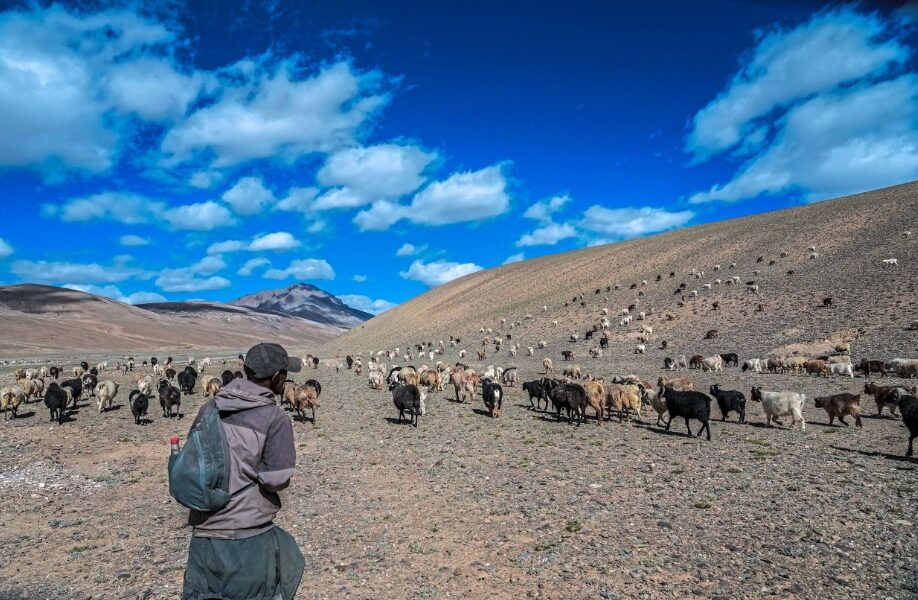Nomadic Life in Ladakh displays a unique blend of culture and survival against the stark yet beautiful backdrop of this high altitude region. The nomads of Ladakh, with their ancient traditions, roam the cold deserts herding goats and sheep and living in harmony with the rugged terrain.
A Ladakh trip is incomplete without understanding the nuances of Nomadic Life in Ladakh, which reveals the heart and soul of this enchanting land, teaching lessons of sustainability and the essence of human endurance, and their festivals including the Ladakh Hemis Festival.
Understanding the Nomadic Life in Ladakh
Nomadic life in Ladakh is a fascinating journey into the lives of people who have adapted to the extreme conditions of the high altitude desert. This region located in the northern part of India is known for its stunning landscapes and unique culture.
The nomads here referred to as Changpas live a life that is deeply mixed with the rhythm of nature.
Their existence is a dance of survival and adaptation, as they move across the vast, barren lands in search of farming grounds for their livestock. This nomad lifestyle in Ladakh is not just about wandering, but also celebrating, and one of the best examples of it is the Ladakh Hemis Festival.
It’s a centuries old tradition passed down from generation to generation teaching the art of living in harmony with the harsh environment.
The Essence of Nomad Lifestyle in Ladakh
The nomad lifestyle in Ladakh is characterized by simplicity and sustainability. The Changpas primarily herd goats and sheep which are not only a source of livelihood but also an integral part of their cultural identity.
These animals provide them with wool, meat, and milk which are essential for their survival in the cold desert climate.
Their homes are known as ‘rebo’ are portable tents made from yak hair, designed to stand the severe weather conditions. These tents showcase the nomadic spirit providing a warm and safe haven as they traverse the rugged terrain of Ladakh.
Seasonal Migration: The Heart of Nomadic Life
Nomadic life in Ladakh revolves around the seasonal migration of the Changpas. They follow a cyclic pattern moving their herds to higher pastures in the summer and returning to lower grounds in the winter.
This migration is not just a physical journey but a cultural ritual that celebrates the bond between the nomads and their environment.
During these migrations, the nomads face numerous challenges, from harsh weather to navigating difficult terrains. Yet, their deep understanding of the land and its patterns enables them to thrive, showcasing an incredible resilience and strength.
Cultural Richness and Traditions
The nomad lifestyle in Ladakh is rich in cultural traditions and practices. Their music, dance, and art are deeply rooted in their daily lives and the natural world they inhabit.
One of the highlights of their cultural calendar is the Ladakh Hemis Festival, a vibrant event that showcases the spiritual and cultural heritage of the region.
The festival is a colorful spectacle of traditional dances, music, and rituals, drawing visitors from around the world. It is a time of joy and celebration where the nomadic communities come together to share their heritage and stories.
Challenges and Changes
Despite the beauty and richness of the nomadic life in Ladakh, it faces significant challenges. Climate change, modernization and the pressures of a growing economy are impacting their traditional way of life.
The delicate balance between nature and the nomads is under threat, raising concerns about the sustainability of their lifestyle and the preservation of their cultural identity.
However, there is a growing awareness and effort to protect the nomadic heritage of Ladakh. Initiatives are being taken to promote sustainable practices and support the nomads in adapting to the changing environment while preserving their cultural legacy.
The Future of Nomad Lifestyle in Ladakh
Looking ahead, the nomad lifestyle in Ladakh stands at a crossroads. As the world changes, the nomads of Ladakh are finding ways to balance tradition and modernity. There is a collective effort to ensure that their unique way of life continues to thrive, not just as a cultural relic, but as a living, evolving practice.
Educational and economic development programs are being introduced, aimed at improving the quality of life for the nomadic communities while maintaining their cultural essence.
There is hope that with the right support and recognition the nomadic life in Ladakh will continue to be a testament to human resilience and cultural richness.
In Conclusion
Nomadic life in Ladakh is a remarkable example of how human beings can live in harmony with nature, adapting to its rhythms and challenges. The nomads of Ladakh, with their rich traditions and sustainable lifestyle offer valuable lessons in resilience, simplicity and the importance of preserving cultural heritage.
As they navigate the challenges of a changing world, their journey continues to inspire and remind us of the enduring spirit of humanity in harmony with the natural world.











